The Indigenous Crops Research Program (ICRP) was created by the White Earth Tribal and Community College in order to promote several interrelated goals. The first of these was to renew or expand interest in useful traditional plants that are currently being neglected. Most Native American Nations have major plant staples that serve as a cornerstone of their culture. For many this is corn. For the Anishinaabeg of the Great Lakes region it is wild rice. These foods continue to maintain their dominant role in Native society, and remain central to social, political, and economic life. This is not the case for a number of secondary crops, many of which have never been brought under cultivation or have been only minimally studied. In our region, some of these include: hazelnuts, chokecherries, black cherries, pin cherries, high bush cranberries, and juneberries. There are also other crops that historically grew outside the Anishinaabe territory that have the potential to expand their range to the White Earth Reservation such as chestnuts, black walnuts, butternuts, and hickories.
A second major goal of the ICRP is to promote perennial woody agriculture. There are several reasons for this. Tree crops have been a life-long passion of mine, but equally important is the fact that the Anishinaabeg were not an agricultural people. They lived a foraging lifestyle with a certain amount of gardening to supplement their gathering. By promoting woody horticulture, we more closely mimic the traditional lifestyle where fire and other tools were used to manage "wild" plantations of the fruits and nuts mentioned above. Woody crops are also one facet of the sustainable agriculture paradigm that resonates with the Indigenous agriculture renaissance movement sweeping across "Indian Country" today.
Finally, many of the plants that are the focus of the ICRP have the potential for multiple yields. For example, black walnuts produce dyes from their husks, an industrial metal polishing grit from the shells, and a high grade timber in addition to the nut crop. Such crops allow for a more diverse income stream and greater productivity.
| Mature hybrid hazelnuts at the Badgersett Research Farm (BRF) (Photo courtesy of Steven Dahlberg.) | 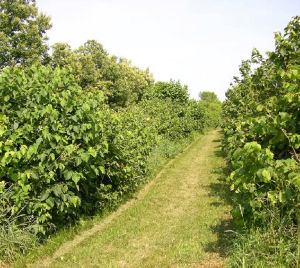 |
The initial focus of the ICRP has been on hazelnuts for several reasons. The Badgersett Research Farm has been working in Minnesota for nearly 30 years to develop hardy, productive hybrid hazelnuts from Native and European parent stock. Their work has lead to a growing interest in hazelnuts across Minnesota making it easy for us to find partners for the project. However, the single most important factor is my fundamental belief that, to be meaningful, an agriculture must produce staple crops. Fruits, though interesting and important, do not fill that role. The hazelnut, on the other hand, has the potential to serve the same role as soybeans do in the industrial agriculture format.
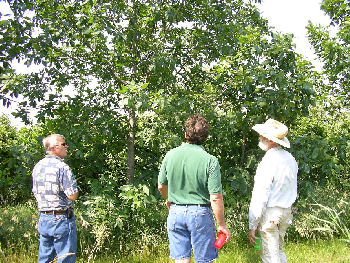 |
The WETCC Extension staff and partnering landowners visit BRF. (Photo courtesy of Steven Dahlberg.) |
With all of the above in mind, the specific objectives we planned to achieve in the first two years of this project were to:
- Begin to test the suitability of the Badgersett hybrid hazelnuts for the growing conditions and cultural practices on White Earth.
- Support research on effective vegetative propagation techniques for hazelnuts.
- Identify and propagate promising wild hazelnuts and other woody plants of interest.
We began, in 2006, by establishing six test plantings on the Reservation each consisting of 250 to 500 of the hybrid hazel seedlings. A similar number of additional hazels will be added to each site in 2007 along with a selection of hybrid chestnuts and hickories from Badgersett, and seedling black walnuts from other sources. This diversity is an important component of Indigenous cropping practices. Most people are familiar with the famous "Three Sisters" of corns, beans, and squash which produce a mutually-supportive community for each other in addition to yields for the gardener. Our hope is to look for woody analogs for this. Mark Shepard, an agroforester from southwest Wisconsin, has already suggested one possibility consisting of chestnuts and hazelnuts supported by various prunus and bramble species. This model is based on the fire hardy woody thickets found on the transition between the eastern forest and the central plains.
In addition to the plantings, we have also identified wild hazelnuts with moderate nut size and good productivity, some very interesting wild blackberries, and black cherries with good fruit characteristics. Seed was harvested from the hazels and black cherries for planting in 2007. The blackberries will be layered and transplanted to some of the test sites.
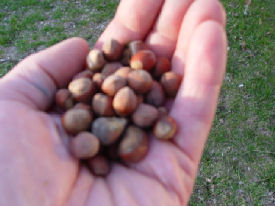 |
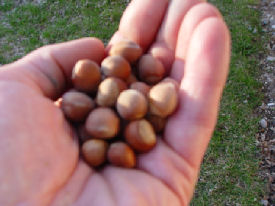 |
| Above are examples of premium wild hazelnuts (left) vs. average hybrid hazelnuts (right). This is the advantage of including European genetics. (Photo courtesy of Steven Dahlberg.) |
A final goal for the ICRP is to promote economic development for the Reservation and similar regions through the adoption of woody agriculture. For that to be successful there needs to be high value products and markets for those products. The next phase of our project is to explore examples of such yields that could be part of a perennial polyculture. one possibility is the many bioactive compounds found in plants. Several classes of these compounds are of particular interest to the personal care products industry, specifically antioxidants, antimicrobials, anti-inflammatory compounds, and various resins, oils, and waxes. The reality of our world is that a face cream that makes you look younger is much more valuable than food. Identifying plants (or plant communities) that produce both will be all the better for our producers and communities.
The ultimate manifestation of the ICRP model is a system of multiple, mutually-supportive, perennial or self-seeding annual crop species each producing multiple yields. The keystone plants of this system are indigenous to North America, but it is entirely counterproductive to try to exclude the many naturalized imports. The inclusion European or Asian genetics in the keystones is an issue of much debate in Native communities and will vary from place to place. Such a system should be simultaneously ecologically and economically resilient and productive. It should be ascetically pleasing and provide a variety of rewarding work for community or family-scale producers.
| The WETCC Extension garden is an example of the ICRP cultural model. Plants visible in this picture include: American plum, Lantham raspberries, daylilies, wild strawberries, common yarrow, Jerusalem artichokes, chives, garlic chives, stinging nettle, currants, comfrey, curly dock, and dandelions. (Photo courtesy of Stephen Dahlberg.) | 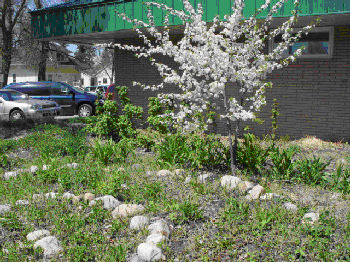 |
By Steven Dahlberg
Science Program Head and Extension Educator
White Earth Tribal and Community College
Mahnomen, Minnesota



